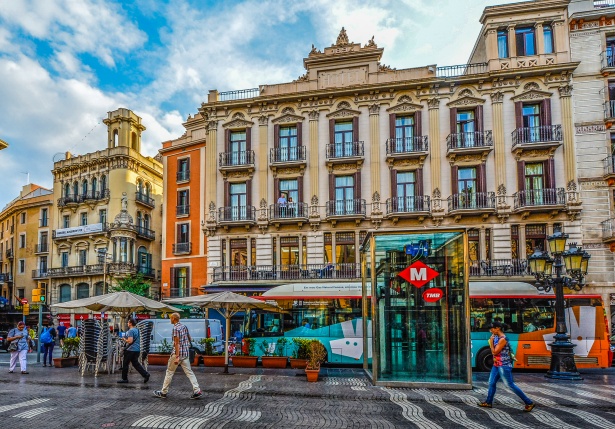Barcelona Cruise Port Guide with Royal Caribbean
Why you should sail from the Barcelona cruise port
Famous for being the capital of Catalonia, Barcelona is one of our favourite port destinations. With its stunning neo-gothic architecture, delicious Spanish cuisine and beautiful scenery, Barcelona is the perfect city to visit on your cruise adventure of a lifetime.
There’s lots to do and see in Barcelona for both single travellers, couples and families, so there’s something for everyone. Whether you’re planning a quick stop in Barcelona on the day of your cruise or you’re staying overnight, we’ve included plenty of ways you can make the most of your visit to the city.
Where is the Barcelona cruise port?
The closest airport to the Barcelona cruise terminal is El Prat International Airport (BCN), which is around 10 miles away from the port. Unfortunately there are no direct transfer options provided by the airport, so we suggest you make your own travel arrangements to get to the port.
Some options include hiring a minibus, using public transport or getting a taxi. Getting a taxi is the most recommended method of travelling between the airport and port, and should cost between €20-30 depending on the taxi operator and rates on the day. If you’re thinking of hiring a rental car, please note that there is no onsite parking at the cruise port.
If you do decide to drive to the port, it should take about 40 minutes depending on the road conditions on the day. The directions of travel from El Prat airport are:
- Exit the El Prat International Airport (BCN) and take the road to Barcelona City.
- Then, take the Ronda Litoral Highway and take the exit marked PUERTO.
- Turn right and then follow the signs indicating PUERTO.
- Royal Caribbean cruise ships are berthed at Adossat Terminal (Moll Adossat).
The full address for Moll Adossat is: Moll Adossat, 1, 08039 Barcelona, Spain
TIP: Don’t forget to allow yourself extra time when travelling to your port destination, as you may be delayed when boarding due to immigration and security purposes.
Getting around Barcelona
Travelling around Barcelona is easy, thanks to the comprehensive public transport system that offers a stress-free and affordable way to discover Barcelona’s stunning sights.
To travel in style, you could hire a scooter to move around the city with ease like a true Spaniard. Driving a car through Barcelona isn’t recommended due to the high volume of traffic the city centre sees everyday, so a scooter will help you get to your destination quicker.
If you’d prefer someone else to be in the driving seat, Barcelona’s public transportation network is the most reliable way of getting from one part of the city to the other. You can travel by bus, train, taxi or the metro (underground).
The metro and bus tickets cost around €2.20 for a single ticket, but if you plan on taking a few journeys throughout the day, you might want to invest in a T-10 ticket which offers multi-person travel for 10 intermodal journeys. The price for a T-10 ticket is dependant on the zone you want to travel through, with the cheapest being €10.20 to travel through one zone.
Food and drink
Barcelona is well-known for its delicious Spanish cuisine, so it’s no surprise that eating out is a major pastime in the city. Despite being a fast-paced city, locals tend to wind down between 2pm and 4pm for a relaxed three-course menú del día (lunch of the day).
Mediterranean dishes fill the menus, so there’s an abundance of fish, vegetables and cold cuts available in almost every restaurant. Pork is a popular meat eaten by locals, as well as Serrano ham and grilled fish.
If you want to experience a real taste of Barcelona, we recommend visiting some artisanal restaurants that are hidden away from the main tourist areas. Breakfast is usually a light, continental affair, so expect lots of fresh bread, flavoursome cold meats and pastries. Lunch is the most important meal to locals and usually takes the form of a three or four-course meal, including fish, meat or vegetable dishes. As lunch is usually quite heavy, many locals enjoy tapas for dinner. We recommend the rustic Catalan tapas, pa amb tomàquet (bread rubbed with olive oil and tomato pulp, served with pâté, cheese or cold cuts).
When it comes to drinking, wine is Barcelona’s tipple of choice. Despite being less renowned than other wines around the world, Catalan wines are some of the most impressive, with Priorat being the standout. For those who prefer beer, San Miguel is the most popular and other beers across the city tend to have a similarly lighter taste.
Water in Barcelona is safe to drink, however many have commented on the unique taste of the tap water. You’re best with bottled water, where non-carbonated is agua sin gas and fizzy water is agua con gas.
For coffee lovers, you’ll be pleased to know that Barcelona’s coffee is as strong as they come, so you can enjoy rich, aromatic cups with guaranteed quality during your trip.
TIP: Some restaurants in Barcelona are closed on Sunday and Monday, so it’s worth checking before you visit to make your restaurant of choice is open.
Things to do and see in Barcelona
There’s lots to see and do in Barcelona for single travellers, families and couples on a romantic getaway alike. Whether you want to see the historic sights of the city or mingle through the daytime markets, there’s always something to suit everyone in Barcelona.
La Sagrada Família
The most-visited monument in Spain which attracts around 2.8 million visitors a year, La Sagrada Família is a breath-taking Roman Catholic church which was first constructed in 1882. The majority of its fame comes from the structure being technically unfinished. Designed by renowned Catalan architect, Antoni Gaudí, the church is also known for its combination of Gothic and Art Nouveau forms, as well as the eight iconic spires.
Park Güell
Another Antoni Gaudí masterpiece, Park Güell is a public park that is comprised of gardens and architectonic elements. First opened to the public in 1926, the park is now a World Heritage Site under UNESCO’s ‘Works of Antoni Gaudí’. The park features various mosaics, fountains and greenery, adding some colour to the peaceful surroundings.
Gothic Quarter
Encompassing the oldest parts of the city of Barcelona, the Gothic Quarter runs from La Rambla to Via Laietana, and from the Mediterranean seafront to the Ronda de Sant Pere. There is plenty to do within the quarter, including visiting various authentic bars and restaurants, as well indulging in handcrafted trinkets and wares from local shops.
La Boqueria
Situated just on the outskirts of the Gothic Quarter, La Boqueria is one of the oldest markets in Europe. The colourful stalls are filled with local delicacies including meat, fruit and vegetables, nuts and seafood. If you’re looking to take home some colourful treats, it’s worth taking a trip to La Boqueria.
Museu Picasso
The Picasso museum is home to one of the biggest collections of works by Spanish artist Pablo Picasso. With more than 4,000 pieces of art housed in its halls, the museum is also home to a library that hosts regular educational activities for families and school trips.
Everything you need to know about money in Barcelona
The currency in Barcelona is the euro and converting your country’s currency to euros is fairly simple and can be done at any foreign currency exchange service.
It’s best ensure you have enough money to last throughout your trip and try to avoid taking traveller’s cheques, as very few vendors accept them as a method of payment.
ATMs are very easy to find around Barcelona, so if you do need to draw out any extra cash, you’ll be able to find a cashpoint quickly. VISA have a handy online locator tool which pinpoints local ATMs on a map.
TIP: Make sure you contact your bank to let them know you’re travelling abroad if you plan on using an ATM. The bank will usually flag up any unusual payments and could temporarily block your card.
Key information to know before travelling
Language
The primary languages in Barcelona are Catalan and Castilian Spanish. English isn’t often spoken among locals, so you might find it hard to navigate the city if you don’t know some basic Spanish words and phrases.
Opening Times
Shops in Barcelona usually open from 9am to 1 - 2pm, with a break for lunch, and re-open around 4.30pm to 8 - 10pm. Restaurants are often closed on a Sunday night and Mondays, but they do stay open until late for the rest of the week.
Weather
Barcelona has a Mediterranean climate, so the summers are hot and the winters are quite mild. The average annual temperature in summer is 28°C and in winter this drops to between 5°C and 14°C.
Safety
Barcelona is generally a safe country to travel to. As with most countries, there is the risk of theft, so always ensure your passport, money and personal belongs are secure. The UK government offers detailed advice on how to keep safe during your trip to Spain.










